Protest Procedures: Step-By-Step Guide for Procurement Challenges
Updated On: October 23, 2025 by Aaron Connolly
Understanding Protest Procedures
Protest procedures lay out the rules and practical steps for demonstrations. They cover everything from your rights as a participant to what organizers need to do.
These guidelines aim to keep protests peaceful and protect both the people involved and the wider public.
Definition and Purpose of a Protest
A protest happens when people gather in public to show disagreement with policies, decisions, or social issues. The main goal? Raise awareness and push for change through peaceful assembly.
Protests work as a core democratic tool. People use them to speak up together when other methods don’t get results.
Key purposes include:
- Getting public attention for certain issues
- Pressuring leaders to rethink decisions
- Building a sense of unity among supporters
- Showing just how many people care
Most democratic countries protect the right to protest peacefully by law. This legal protection lets people speak their minds without worrying about punishment.
But protests have to stay peaceful to keep that protection. If things turn violent or property gets damaged, you could face criminal charges—and public support could fade fast.
People use different protest types for different reasons. Some want media coverage, while others try to disrupt normal activities and force a conversation.
Key Parties Involved
Protesters show up to voice their opinions. They have rights, sure, but they also need to stay peaceful and follow lawful instructions.
Organisers do the behind-the-scenes work. They handle permits, talk to authorities, and make sure everyone knows the rules and safety tips.
Law enforcement keeps the peace and protects everyone at the event. Their job is to help protests happen safely and keep both participants and bystanders out of harm’s way.
Local authorities might require permits for larger events. They decide things like where you can protest, how long it can last, and how big the crowd can be.
Counter-protesters sometimes show up with opposing views. This can make things tense, so organizers and police need to manage crowds carefully.
Media representatives cover protests and report what happens. Their coverage can spread the protest’s message further, but it might also affect how people behave.
Bystanders and local residents can feel the impact of protests—especially if streets get blocked or things get noisy. Organizers need to balance protest rights with the needs of the community.
Types of Protests
Rallies and speeches bring people together in one spot to hear speakers. These usually need permits, and organizers often set up sound systems so everyone can hear.
Marches move from one place to another. Marches reach more people and can make a strong visual statement for the media.
Vigils are quieter, often held at night with candles or lights. They usually feel more solemn and less confrontational.
Pickets happen outside specific places, like businesses or offices. Workers often use pickets during labor disputes to draw attention to their cause.
Sit-ins involve people occupying a space to block normal operations. These actions are peaceful but often cross into civil disobedience, so arrests for trespassing aren’t uncommon.
Online protests use social media and digital tools to organize and spread messages. They’re a good supplement to physical protests but don’t have the same visual punch.
Each protest type needs its own planning. For example, marches require route planning with authorities, while rallies need venues and sound equipment.
When to File a Protest
You have to time your protest right and make sure you have valid grounds if you want to challenge a procurement decision. Knowing the rules, deadlines, and circumstances gives your protest its best shot.
Eligible Circumstances
You can file a protest if you spot issues in the solicitation or procurement process that hurt your chances of winning. The most common reasons? Restrictive specs that give one bidder an unfair edge.
Defective solicitation terms also open the door to protest. If requirements are unclear, self-contradictory, or just impossible to meet within the budget or timeline, that’s a problem.
Improper evaluation procedures are another reason to protest. If the agency skips its own scoring rules or messes up the math, you have a real case.
You need to be an “interested party” to file. In plain English, you must be a real or potential bidder with a direct financial stake in the outcome.
If the award relies on wrong info or bias, you can protest—but you’ll need solid evidence, not just a hunch.
Relevant Timeframes
Pre-award protests have to happen before proposals are due if you see problems in the solicitation. Don’t wait until after you lose to speak up about obvious issues.
Post-award protests move much faster. You get 10 days after the contract award or 5 days after your debriefing, whichever comes later.
GAO usually decides protests within 100 days. If you go for the express option, you’ll get a decision in 65 days, but it’ll cost more.
The agency has 30 days to respond after GAO notifies them. For express cases, they get 20 days unless GAO says otherwise.
Automatic stay provisions kick in if you file on time. This means the agency can’t award the contract or has to pause performance until the protest gets resolved.
Typical Deadlines
| Protest Type | Filing Deadline | Agency Response | GAO Decision |
|---|---|---|---|
| Pre-award | Before proposal due date | 30 days | 100 days |
| Post-award (standard) | 10 days after award | 30 days | 100 days |
| Post-award (express) | 10 days after award | 20 days | 65 days |
Filing fees have changed lately. Protests filed before October 2024 cost £280 (about $350). New protests now run £400 (about $500).
You need to send a copy of your protest to the contracting officer within one day of filing with GAO. Miss that, and your protest could get tossed out immediately.
Late protests almost never succeed unless you can prove you couldn’t have known about the problem earlier. The GAO sticks to timing rules, so don’t expect exceptions.
If you’re thinking about filing, act fast. Gather your evidence, talk to a lawyer, and file well before the deadline to avoid getting dismissed on a technicality.
Who Can File a Protest

Not just anyone can file a bid protest if they don’t like a government contract award. Only certain parties with a direct interest in the procurement can legally challenge the agency’s decision.
Definition of Interested Parties
An interested party has a direct financial stake in the government contract. You need to show the contract award actually affects your business in a real way.
The Government Accountability Office (GAO) asks interested parties to prove they have standing. Basically, you have to show you could win the contract if your protest succeeds.
Here are the main types of interested parties:
• Actual bidders who submitted offers
• Prospective bidders blocked from submitting offers
• Prime contractors challenging subcontractor rules
• Subcontractors (but only in rare cases)
You can’t file a protest just because you don’t like the government’s choice. You need to show you have money on the line.
GAO will toss protests from people who can’t prove standing. If you can’t show you’d get the contract even if you win, they won’t hear your case.
Bidder Eligibility Requirements
As a bidder, you have to meet certain requirements to file a protest. First, you must be an actual or prospective offeror for that contract.
Actual offerors are companies that put in bids or proposals. You’ve got the strongest case if you were in the running for the work.
Prospective offerors can protest too, but only in specific situations. You need to show the solicitation itself blocked you from bidding when you otherwise would have.
Key eligibility criteria include:
• You submitted an offer or were blocked from doing so
• Your business can actually do the contract work
• You file within the deadline
• You meet legal standing rules under procurement law
GAO might ask for proof of eligibility during the process. Be ready to show your technical skills and past work on similar contracts.
Heads up: Filing a protest without standing wastes your time and money. GAO dismisses baseless protests fast, and you could rack up legal costs with no chance of winning.
Grounds for Filing a Protest

You need specific legal grounds to file a protest that actually hurt your shot at winning a contract. Most protests point to problems in how the solicitation was written, mistakes in evaluating bids, or errors in the contract award process.
Improprieties in the Solicitation
Solicitation problems show up when procurement documents have errors, vague requirements, or unfair rules that keep competition from being fair.
Ambiguous specifications are a top reason for protest. If requirement documents use fuzzy language or contradict themselves, bidders can’t prepare solid proposals. This pops up a lot in technical specs that reference old standards or clash with other sections.
Restrictive requirements that favor one bidder also count as valid grounds. This happens when specs only fit one vendor’s product or when experience requirements unfairly block out competition.
Missing information is another big issue. If solicitations leave out key details about evaluation criteria, contract terms, or performance needs, the process isn’t fair.
Main solicitation issues:
- Conflicting technical requirements
- Unrealistic delivery times
- Biased criteria for evaluation
- Missing cost breakdowns
Small businesses often get the short end when solicitations have overly complex requirements that only big companies can meet.
Errors in Bid Evaluation
Evaluation mistakes happen when contracting staff don’t stick to their own criteria or mess up the math.
Improper scoring is the most common error. This happens when evaluators ignore their own scoring methods or weigh factors wrong. Sometimes departments just skip their own technical rules.
Math errors in final scores are clear grounds for protest. These can be as simple as adding up numbers wrong or not weighing price and technical factors the way they said they would.
Failure to evaluate all factors listed in the solicitation is another valid reason. If departments ignore some criteria or don’t check technical skills, that’s a problem.
Documentation issues also matter. If evaluation records are missing or don’t explain scoring decisions, that’s a procedural violation.
Common evaluation errors:
- Wrong price calculations
- Not checking bidder qualifications
- Applying criteria inconsistently
- Skipping technical reviews
Contract Award Issues
Award problems pop up when departments pick bidders who don’t meet the rules or skip proper procedures.
Responsibility determinations often cause disputes. If a department awards a contract to someone who lacks the right experience, qualifications, or finances, other bidders have a solid reason to protest.
Lowest responsive bidder issues come up when departments pick a more expensive or non-compliant bid without a good reason.
Procedural violations during the award phase are strong protest grounds. If staff skip insurance checks, ignore references, or miss mandatory qualifications, that’s not okay.
Late bid acceptance is another issue. Accepting proposals after the deadline—without a real reason—undermines the whole process.
Typical award problems:
- Skipping financial checks
- Missing required certificates
- Ignoring experience requirements
- Mishandling emergency procurement
You have to move fast—usually within 5-10 working days after learning about an award issue—if you want to protect your rights.
Protest Filing Procedures

Filing a bid protest takes a few clear steps and some paperwork. You usually have just 10 days from when you found out about the issue, and the filing fee runs between £350 and £500 depending on where you file.
Submission Requirements
Who Can File: Only interested parties with a direct economic interest in the procurement can file a bid protest. You need to be an actual or prospective bidder who could win the contract if your protest works.
Timing Deadlines: You face strict time limits for filing protests.
- Pre-award protests: File within 10 days of when you knew—or should’ve known—about the solicitation issue.
- Post-award protests: File within 10 days of debriefing, or within 5 days of learning about the award.
Filing Venues: You can file protests in three main places.
- Contracting agency (usually the fastest—often resolved in about 30–35 days)
- Government Accountability Office (GAO) (most common)
- Court of Federal Claims (mainly for bigger contracts)
Filing Fees: GAO charges a filing fee—£500 as of October 2024. Protests at the agency level usually don’t have a filing fee.
Format and Contents of a Protest
Required Elements: Every protest needs to include specific info to count. You have to clearly state the legal and factual reasons for your challenge.
Electronic Filing: GAO wants all new protests through their Electronic Protest Docketing System (EPDS). Only protests about classified material can go in on paper.
Copy to Agency: You have to send a complete copy of your protest to the contracting officer at the same time. This lets the agency respond to your claims.
Key Content Requirements:
- Clear statement of your protest grounds
- Specific allegations with supporting facts
- Relief sought (what you want the agency to do)
- Certificate of service showing you notified everyone
Supporting Documentation
Evidence Gathering: Gather all relevant documents before you file. That means the solicitation, your proposal, debriefing notes, and any emails or letters with the agency.
Protective Orders: Many protests involve confidential competitor info. You might need to request a protective order to see sealed documents or competitor proposals.
Administrative Record: The contracting agency has to file an administrative record with all documents about the procurement decision. Check this closely—it often has the evidence you need.
Expert Witnesses: For complicated technical protests, think about bringing in expert witnesses to explain why the agency’s evaluation didn’t make sense. This really matters for protests about technical specs or past performance.
Protest Timing and Deadlines
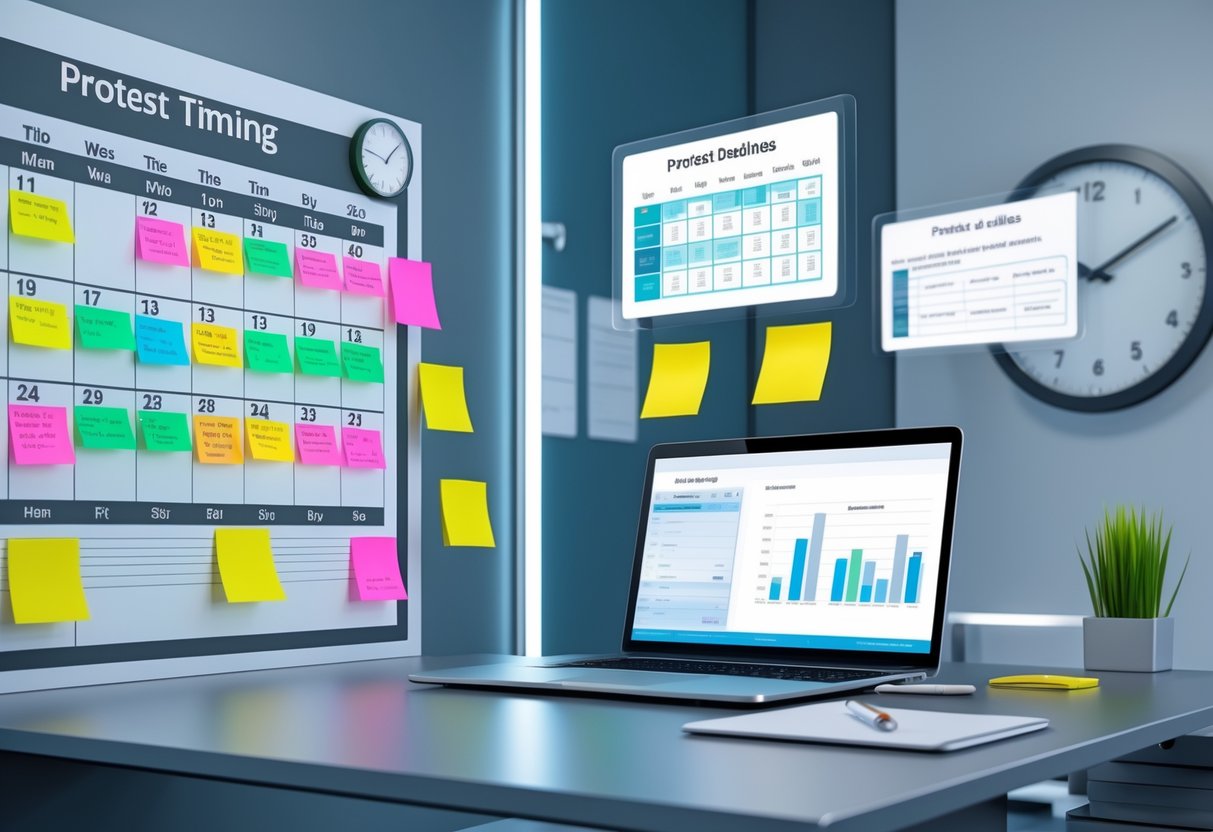
Timing can make or break a bid protest. Miss a deadline and your case is done before it starts.
The rules change depending on if you’re protesting before or after the contract award. Some situations are urgent, and there are rules for extensions, but don’t count on them.
Protests Before Award
You have to file pre-award protests within 10 days of when you knew or should’ve known about the issue. This covers problems with the solicitation, evaluation criteria, or procurement process.
Key deadlines:
- Solicitation issues: 10 days after the solicitation comes out
- Amendment problems: 10 days after the amendment is published
- Evaluation concerns: 10 days after you spot the issue
That 10-day rule is strict. GAO won’t accept late filings unless you can show something truly exceptional stopped you.
If GAO gets your protest, the agency can’t award the contract unless the head of contracting activity writes up a special finding. That finding has to show that urgent circumstances affecting US interests require immediate award, and the award will happen within 30 days.
Critical timing tip: If you have a problem with the solicitation language, file early. Don’t wait until you lose to challenge requirements you saw coming.
Protests After Award
Post-award protests have tighter deadlines but clearer rules. You’ve got 10 days from the contract award or 5 days after a required debriefing—whichever is later.
Here’s how the timeline usually works:
- Contract awarded on Day 1
- You request a debriefing by Day 3
- Agency gives the debriefing on Day 8
- You have until Day 13 to file (5 days after debriefing)
A lot of people think it’s always “10 days from debriefing.” Not quite. It’s 10 days from award or 5 days from a required debriefing—whichever gives you more time.
Important to note: Not every procurement requires a debriefing. If there’s no debriefing, you only get 10 days from the award.
When GAO receives a timely post-award protest, the contracting officer has to immediately suspend or end the contract. Only the head of contracting activity can let performance continue, and only with a written authorization.
Urgency and Extensions
GAO uses express and standard review options based on how urgent things are. Express cases get decided in 65 days instead of the usual 100.
Express option fits when:
- The procurement is urgent
- Performance periods are short
- There are seasonal needs
The agency has to pull together its protest file in 30 days for standard cases, or 20 days for express. That file includes all the documents, evaluation materials, and the contracting officer’s legal memo.
Extensions are rare:
- GAO might grant extra time for good cause
- Agencies can ask for more time to compile files
- Additional document requests need to come in within 2 days
Critical point: Don’t assume you’ll get an extension. Stick to the deadlines and file early if you can.
If you’re thinking about a protest, act fast. These deadlines are jurisdictional—GAO can’t waive them, even if your case is strong.
The Agency Review Process

Government agencies have to follow clear steps when handling procurement protests. They notify bidders about review options, investigate complaints, and make decisions within set timeframes.
Notification to Bidders
Agencies have to let potential bidders know about protest options before bidding starts. You’ll find this notice in the solicitation documents.
The notification lays out two review paths. Bidders can file straight with the contracting officer, or ask for an independent review from a higher official.
The notice should say if the independent review is:
- An alternative to the contracting officer’s review
- An appeal after the contracting officer decides
Most agencies put this in their standard templates to avoid confusion later.
Some agencies even include contact info for protest officials, plus deadlines and documentation requirements in the first notice.
Investigation and Resolution
When we get a protest, the contracting officer starts investigating right away. The agency gets 35 days from the filing date to resolve the protest.
The investigation process:
- Reviewing all procurement documents
- Getting statements from evaluation team members
- Looking at the protester’s specific claims
- Checking compliance with federal rules
Agencies have to suspend contract performance if they get a protest within 10 days of award. The suspension lasts until the agency resolves the protest or justifies urgent performance.
The contracting officer can ask for more info from all parties. They might hold informal chats to clarify technical or procedural points.
Independent reviewers can’t have been involved in the procurement before. This keeps the review fair.
Possible Outcomes
Agency protest decisions usually fall into three categories. Each outcome brings specific next steps for both sides.
Protest sustained: The agency agrees with the protester. They have to take corrective action like re-evaluating proposals or canceling the award.
Protest denied: The agency finds no merit in the protest. The original decision stands, and contract performance can move forward.
Protest dismissed: The protest didn’t meet filing requirements or lacks jurisdiction. This often happens with late filings or not enough detail.
All decisions need a written explanation of the agency’s reasoning. The protester gets this decision through a method that proves delivery.
If you disagree with the agency’s decision, you can still file with the Government Accountability Office—but you only get 10 days from when you receive the agency’s decision.
Appeals and Reconsiderations
When a bid protest decision doesn’t go your way, you’ve got two main options left. You can ask for reconsideration within strict time limits, or you might appeal through different forums depending on where you filed first.
Grounds for Appeal
The reasons for appealing a protest decision really depend on where you filed. GAO protests have the most structured path for reconsideration.
For GAO, you can request reconsideration if new facts come up, or if you think the original decision had errors in law or fact. GAO wants specific grounds—not just general disagreement.
Agency-level protest appeals usually go to higher contracting officials. These appeals need to show procedural mistakes or that the original decision maker missed key facts.
Court appeals are the most formal. The Court of Federal Claims can review GAO decisions or hear original protests. You’ll need to prove the agency broke procurement rules or acted arbitrarily.
| Forum | Appeal Destination | Required Grounds |
|---|---|---|
| GAO | GAO Reconsideration | New facts or legal errors |
| Agency | Higher contracting official | Procedural errors |
| Court | Appellate court | Violation of law |
Requesting Reconsideration
Filing for reconsideration means you need precise documentation and clear legal arguments. Start with your specific basis for the request—don’t just repeat the original protest.
For GAO, your request has to point out new info that wasn’t available before, or show that GAO misunderstood facts or applied the law wrong.
Format your request professionally: Use numbered paragraphs and specific citations. Include any new supporting documents.
You have to serve copies on all interested parties at the same time. This means the contracting agency and any other contractors who were part of the original protest.
Time Limits for Appeal
GAO reconsideration requests have a hard 10-day deadline from when you knew—or should’ve known—the basis for reconsideration. There aren’t any extensions.
Agency appeals usually allow 7–14 days, depending on the agency. Check your protest decision letter for the exact number.
Court appeals have their own rules. If you’re appealing a GAO decision to federal court, you usually get 30 days from the GAO decision date.
Miss these deadlines and your appeal rights are gone for good. File as soon as you spot grounds—don’t wait to perfect your arguments.
| Appeal Type | Time Limit | Starts From |
|---|---|---|
| GAO Reconsideration | 10 days | Knowledge of basis |
| Agency Appeal | 7–14 days | Decision receipt |
| Federal Court | 30 days | GAO decision date |
Protests to Higher Authorities
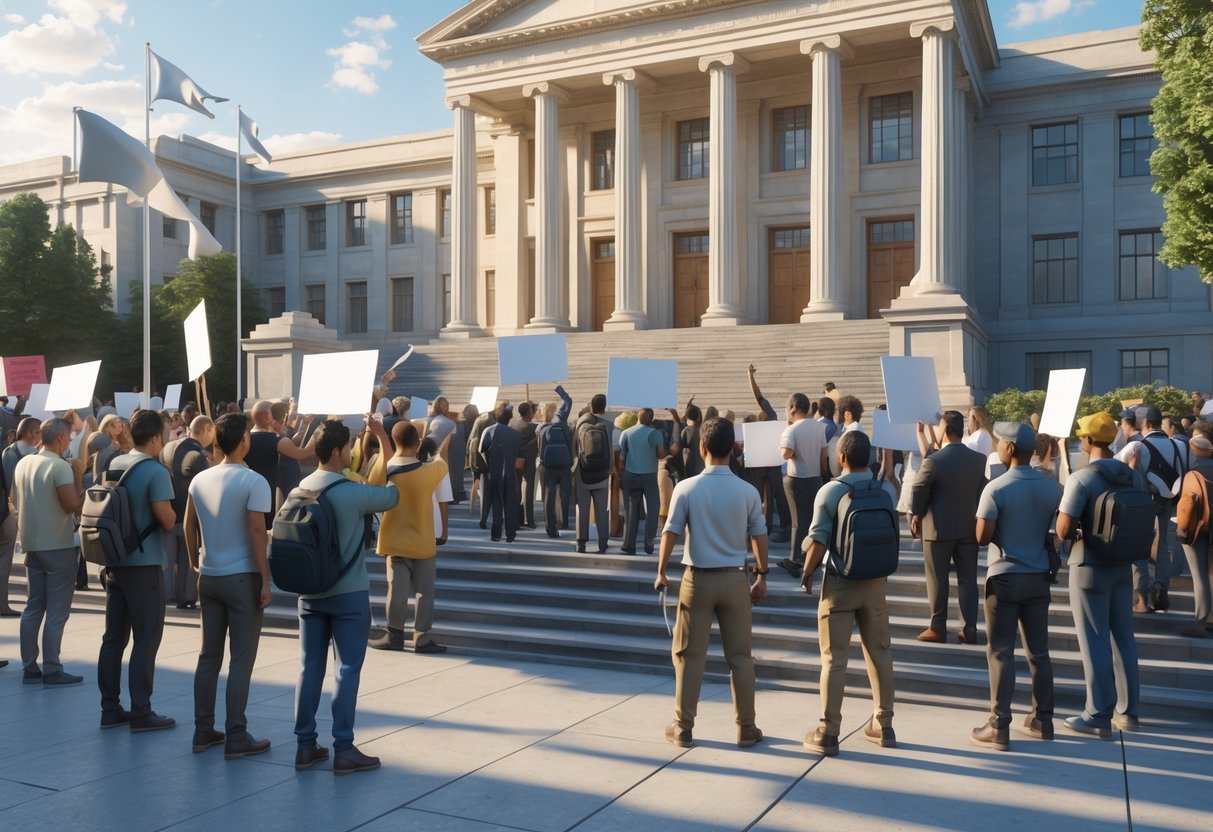
If agency-level protests don’t solve your problem, you can take things up to independent review bodies. The Government Accountability Office (GAO) is the main external forum, offering structured procedures and binding recommendations for federal procurement disputes.
Options Beyond the Contracting Agency
Several independent forums handle bid protests if the agency process doesn’t work out. GAO handles most federal procurement protests under procedures in 4 CFR Part 21.
Primary External Forums:
- Government Accountability Office (GAO) – handles federal procurement protests
- Court of Federal Claims – reviews construction, national security, and commercial item contracts
- Administrative Procedures Act challenges in federal court
GAO offers standard (100 days) and express (65 days) review options. Express procedures are faster but only apply in certain situations.
Court cases usually take longer and cost more than GAO protests. Courts can award money damages, while GAO gives recommendations.
Pick your forum carefully. Each has different limits, rules, and remedies for successful protesters.
GAO and Other Forums
You have to file with GAO within 10 days of knowing the protest basis. At the same time, you must send a complete copy to the contracting officer within one day of filing with GAO.
GAO Process Timeline:
- Day 1: File protest with GAO and notify agency
- Day 30: Agency submits complete report (20 days for express option)
- Day 40: Protester files comments on agency report
- Day 100: GAO issues decision (65 days express)
Required Documentation:
- Complete protest filing
- Relevant solicitation documents
- Evaluation materials
- Contracting officer’s statement of facts
The agency has to suspend contract performance if you file within 10 days of award. The head of contracting activity can override this, but only for urgent circumstances affecting US interests.
Protective orders keep sensitive commercial info safe during the process. Ask for these early if your protest involves proprietary data or trade secrets.
Escalation Procedures
If you want to file a protest, start at the right organisational level for what you hope to achieve. If you send a protest to a higher level, they’ll usually send it down to the contracting office first.
Escalation Hierarchy:
- Contracting Officer – handles the first review
- Head of Contracting Activity – hears appeals at the agency level
- GAO – offers an independent external review
- Federal Courts – provides judicial review
Track your escalation path as you go. Higher-level reviewers expect to see that you tried to resolve things at lower levels first, and that those efforts didn’t work out.
Critical Timing Requirements:
- Agency protests: within 10 days after you know the basis
- GAO protests: within 10 days after you know the basis
- Post-award GAO protests: within 10 days of award or 5 days after debrief
You can’t file protests in more than one place at the same time. Pick one forum and finish that process before trying another.
Gather all the documentation that supports your case. As you escalate, higher authorities look for detailed records and expect formal legal arguments—not just informal complaints.
Impacts of Filing a Protest
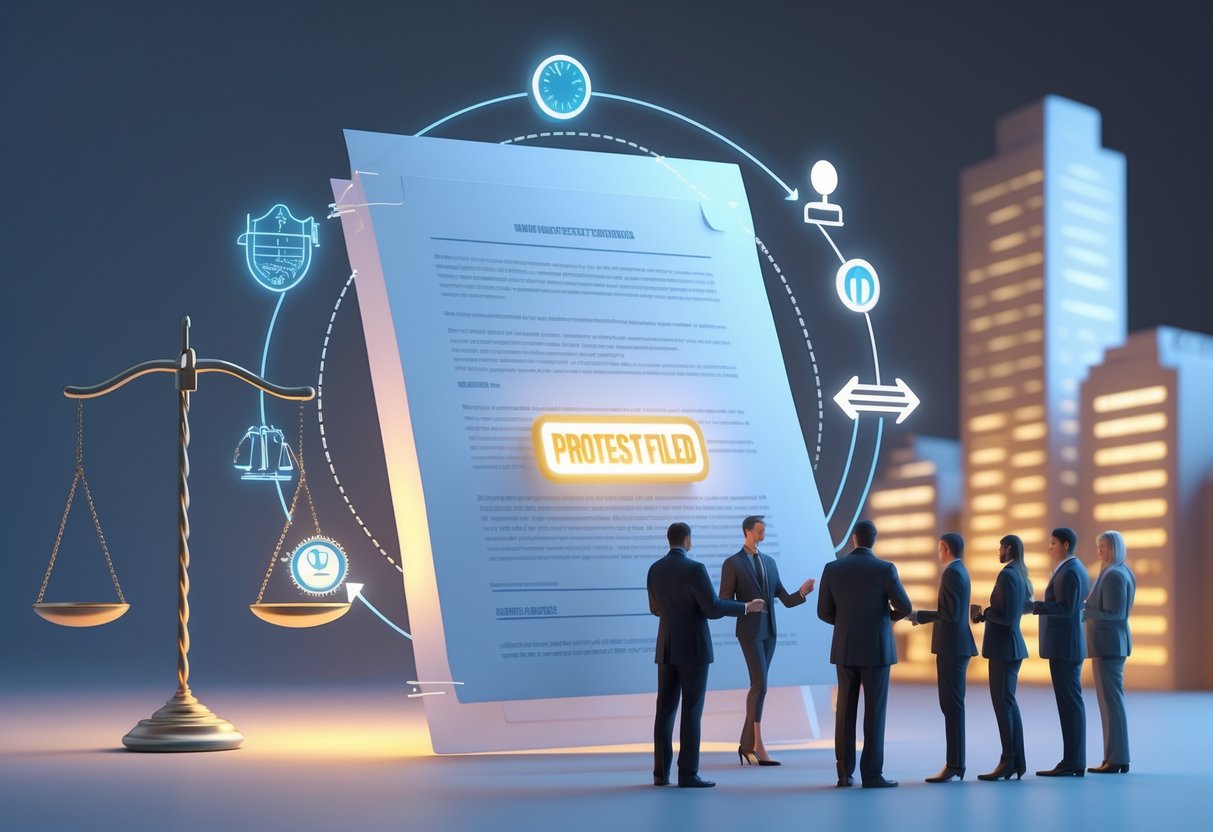
Filing a protest shakes up the procurement process for everyone involved. Once you file, the contract award comes to a halt, and agencies have to address the protest before moving forward.
Effects on Contract Award
When we file a protest, the agency stops the contract award process right away. This automatic stay gives all bidders some breathing room while the protest gets sorted out.
The contracting officer can’t give the contract to anyone during the protest. If they’ve already awarded it, they have to pause the work.
This rule applies no matter where you file—agency, GAO, or Court of Federal Claims. The stay remains in effect until someone resolves the protest.
For GAO protests, the stay can last up to 100 days. Agency protests might be shorter or longer, depending on their own timelines.
Sometimes, agencies can override the stay. They have to show urgent need or that the protest obviously lacks merit.
Delays and Potential Remedies
Protests can slow down procurement by weeks or even months. GAO, for example, has up to 100 days to decide. Agencies set their own schedules, which might be faster or slower.
Delays affect everyone. The winning bidder can’t get started, and the rest of us are left waiting.
If we win, the agency might have to re-evaluate proposals or even scrap the solicitation.
Common remedies include:
- Re-opening the competition for all bidders
- Fixing evaluation errors and re-scoring proposals
- Awarding the contract to the right bidder
- Reimbursing our bid and protest costs
The protest process aims to keep government procurement fair. Still, it adds time and costs that can throw off project schedules.
Best Practices for Protest Procedures
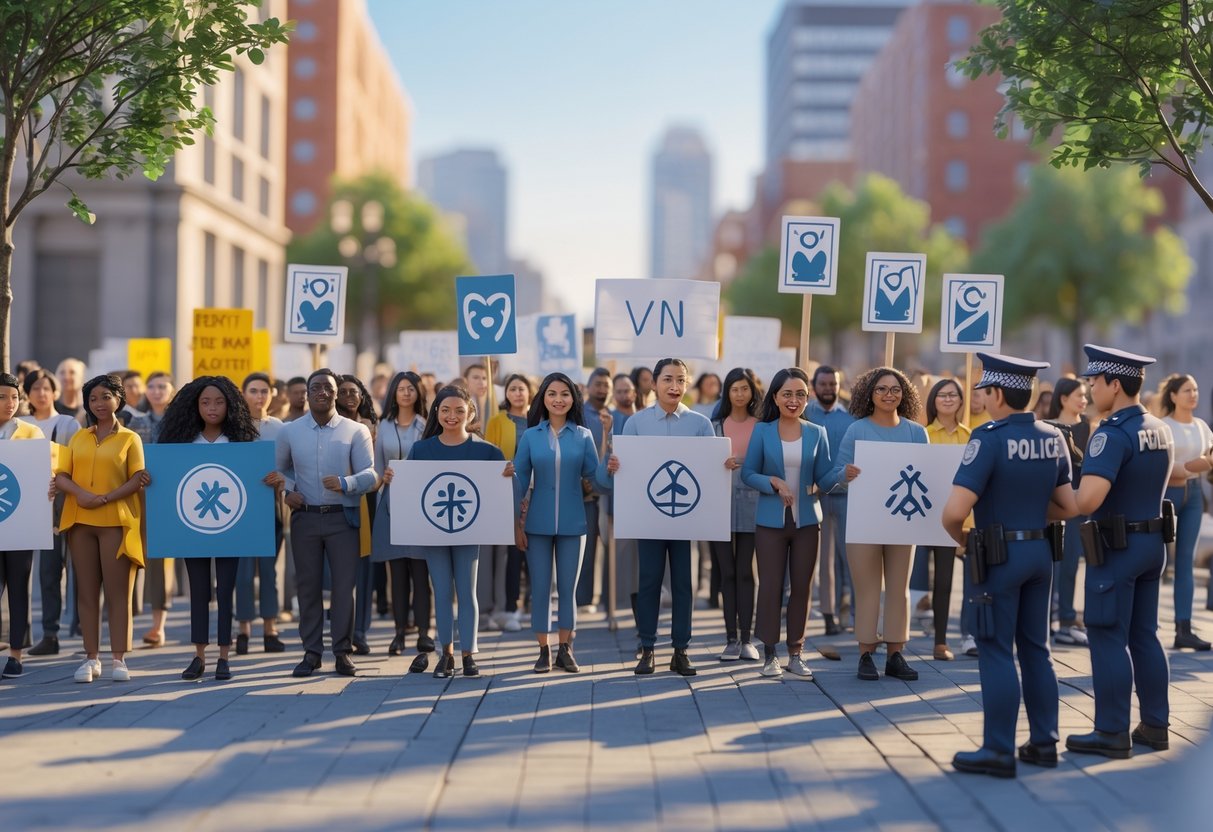
Following smart procedures keeps protests safe, legal, and effective, while protecting everyone’s rights. A bit of planning and avoiding obvious mistakes can really make the difference between a smooth event and one that runs into legal trouble.
Tips for Success
Build relationships before you need them. Connect with local officials, police, and community groups well in advance. Those ties help when things get tense.
Get your permits sorted early. Don’t leave permits to the last minute. Apply weeks ahead if you can. This shows you’re serious and lets authorities review your plans properly.
Train everyone involved. Brief protest marshals and organisers. Cover legal rights, de-escalation techniques, and emergency procedures. Make sure people know their roles and the event’s ground rules.
Communicate clearly and often. Share facts about your protest’s purpose, route, and expected turnout. Use social media, press releases, and direct outreach. Let people know about your safety plans.
| Key Communication Points | Why It Matters |
|---|---|
| Event purpose and goals | Reduces misunderstanding |
| Planned route and timing | Helps authorities prepare |
| Expected crowd size | Enables proper resource allocation |
| Safety measures in place | Builds community confidence |
Set up proper information sharing. Give participants ways to report concerns or threats. Make sure organisers can reach police quickly if something comes up. Good communication can keep small issues from turning into big ones.
Avoiding Common Mistakes
Don’t ignore local laws and regulations. Every area has its own rules about weapons, masks, and group activities. Do your homework and include those restrictions in your planning. Missing this step can cause legal headaches and safety problems.
Avoid last-minute emergency measures. Rushed decisions create legal risks. Courts don’t look kindly on rules thrown together at the last second, especially if they seem targeted.
Don’t treat all attendees the same way. Your permit covers your group, but others might show up. Make sure safety rules apply to everyone—protesters, counter-protesters, and bystanders. Post clear signs at entry points.
Stop misinformation quickly. False info spreads fast online and can stir up trouble. Assign someone to watch social media and respond to rumors right away. Trusted community voices can help set the record straight.
Never assume one-size-fits-all security. Every community is different. What works in a small town might flop in a big city. Think about your specific context and local relationships.
Legal and Regulatory Framework
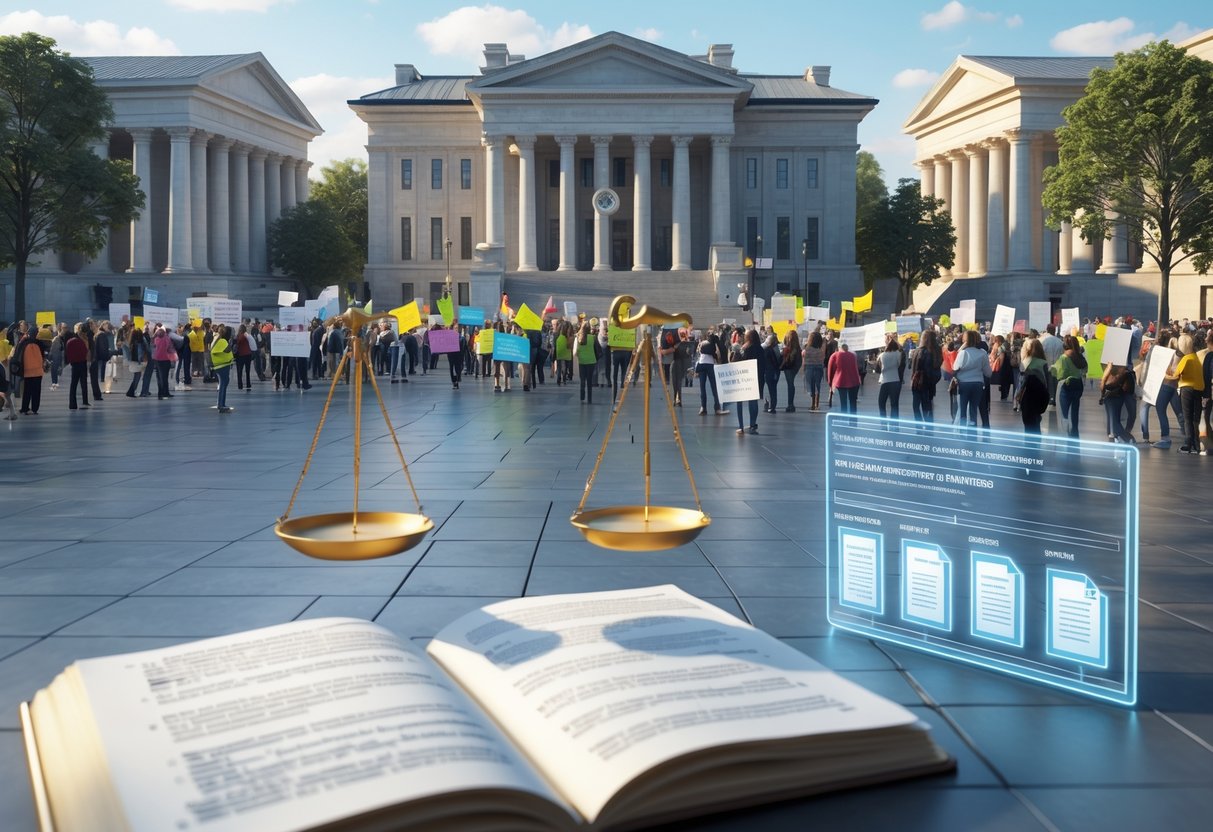
If you’re organizing a protest, you need to understand the legal landscape. The rules try to balance First Amendment rights with public safety through specific laws and policies.
Applicable Laws and Policies
The First Amendment protects peaceful assembly and free speech in the U.S. But these rights come with reasonable restrictions.
Most local councils require permits for big gatherings. Permits help authorities plan for crowd control and safety. Some cities have “free speech zones” where you can protest without a permit.
Key legal considerations include:
- Time, place, and manner restrictions – authorities can set when and where protests happen
- Noise ordinances – limits on amplified sound at certain times
- Traffic regulations – rules about blocking roads or sidewalks
- Property rights – different rules for public and private property
Many places have specific policies for handling large demonstrations. These outline how police should respond while respecting your rights.
Training manuals and disciplinary rules help keep officers on track. Regular policy reviews make sure procedures stay current.
Compliance Obligations
Protest organisers have to follow legal requirements to avoid trouble. Start by checking local laws before you plan anything.
Essential compliance steps:
- Research permit requirements at least 30 days ahead
- Submit applications with full event details
- Coordinate with authorities on routes and safety
- Get insurance if needed
Participants have responsibilities too. Stay peaceful and follow lawful police instructions. Violence or property damage can get you arrested and hurt your cause.
Common violations to avoid:
- Blocking emergency vehicle access
- Trespassing on private property
- Ignoring dispersal orders
- Carrying banned items like weapons
If you need equipment—security, barriers, sound systems—follow local procurement rules. Some places require approved vendors for public events.
If you don’t comply, you could lose your permit, get fined, or face legal action. Working with legal advisers can help you stay on the right side of the law.
Frequently Asked Questions
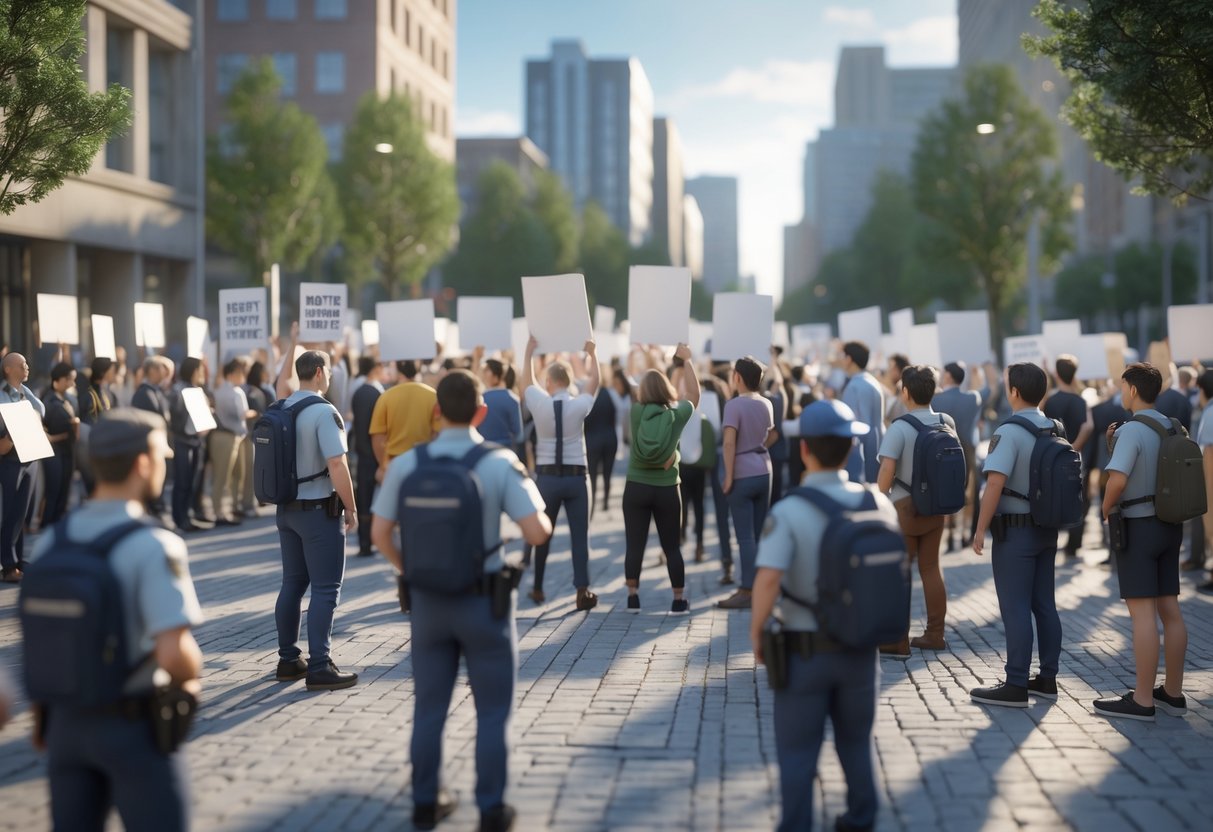
Filing a protest over a government contract means knowing the deadlines, having solid grounds, and picking the right place to file. Most protest processes come with tight time limits and very specific documentation rules.
What steps must be taken to lodge a grievance against a government contract award?
Start by identifying valid grounds for your challenge. Clearly document any evaluation errors, solicitation issues, or improper awards.
Decide where to file your protest—GAO, Court of Federal Claims, or with the agency itself.
Pull together all relevant documentation. Lay out the facts, legal arguments, and what you want as a remedy.
Make sure to submit your protest on time. Each forum has strict deadlines and requirements.
Stay involved in the process. Respond to requests for more info and take part in any hearings.
How long does one have to file an objection following a contract award announcement?
Deadlines for protests are tight. Miss them, and you usually lose your shot.
Most protests need to be filed soon after you spot unfair treatment. The exact window depends on where you file.
For GAO protests, you generally have 10 days from when you knew—or should’ve known—about the issue. Sometimes you get more time, but not always.
Agency-level protests might have different deadlines. Always check the agency’s written procedures.
Could you explain the process of contesting a government contract?
Start by reviewing all the procurement documents. Look for mistakes in the solicitation, evaluation, or award decision.
Gather evidence to support your claim. Document any rule-breaking, errors, or unfair treatment.
Pick the right protest forum. Think about cost, how fast you need a decision, and what you want as a remedy.
Write your formal protest. Include the facts, your legal argument, and what you’re asking for.
File before the deadline. After that, stay engaged as the process unfolds.
What are the valid grounds for raising concerns over a government contract award?
You can protest if the solicitation itself is unfair or has problematic terms.
Evaluation errors also count—things like bias or improper scoring.
If you think the award decision is flawed, that’s a valid reason to protest.
Procedural violations during procurement can justify a protest too. Agencies have to follow their own rules.
If the agency’s documentation is lacking or doesn’t meet requirements, that’s another possible ground.
Which entity is appropriate to approach when filing a formal dispute against a contract procedure?
GAO handles most federal contract protests and has a formal process for challenges.
The Court of Federal Claims is another option, especially for complex cases or if you’re seeking damages.
Agency-level protests go straight to the contracting agency. Each one has its own internal protest procedures.
GSA’s Suspension & Debarment Division handles some specific agency protests and supports the Agency Protest Official.
Pick the forum that fits your needs, your timeline, and your desired outcome. Each has its own pros and cons.
In what circumstances may an entity challenge the outcome of a government procurement process?
If you feel evaluators treated your proposal unfairly, you can file a protest. Maybe they overlooked your qualifications or missed key details—that’s worth challenging.
When you spot defects in the solicitation that put your bid at a disadvantage, you have a reason to object. Usually, you need to raise these issues before you submit your proposal.
Sometimes, agencies award contracts without following their own selection process. If they ignore stated criteria, you should question that decision.
If someone breaks procedure at any point during procurement, you can protest. Agencies really have to stick to their own rules from start to finish.
Conflicts of interest or bias can mess with the outcome, too. If you see signs of that, document it—those are valid reasons to challenge the process.

